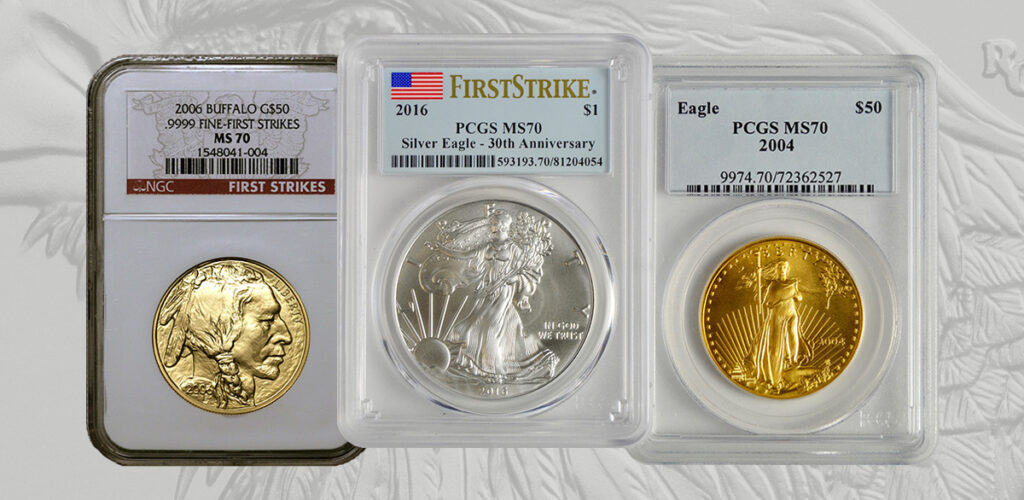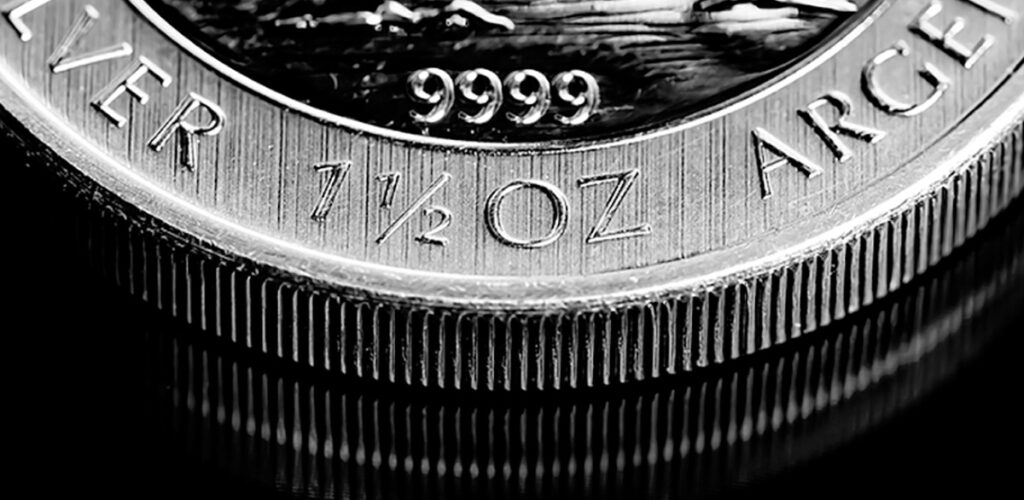More and more investors have been raising questions about modern graded coins, dealer-exclusive coins, and other confusing coin dealer offerings. These misleading descriptors often lead people to believe a gold or silver coin is more valuable than it is, resulting in significant financial loss.
In this week’s The Gold Spot, Sr. Precious Metals Advisor Steve Rand and Precious Metals Advisor Richard Otto revisit these deceptive coin dealer tactics, highlight commonly targeted coins, and offer tips to help investors avoid these pitfalls.
The Reality of Modern-Graded Coins

An alarming number of coin dealers have adopted a strategy of dressing up newly minted bullion coins with clever marketing, leading investors to believe these graded bullion coins are more valuable than they truly are. The truth about modern graded bullion coins is that most are only worth their weight in gold or silver.
Some coin dealers attempt to obscure this fact by emphasizing the coin’s high grade, but the condition often doesn’t mean much in the context of new bullion. Standard bullion coins are made for investment, not circulation. Plus, mints typically produce them in massive quantities. The result is a high volume of bullion coins in mint-state condition every year.
When so many coins are already in excellent shape, the condition alone doesn’t add much value. High grades can certainly boost a coin’s worth, but only when exceptional quality is the exception, not the norm.
What About Dealer-Exclusive Coins?

Another tactic some coin dealers use to justify inflated prices is branding coins as dealer-exclusive. In these cases, official government or private mints–like the Perth Mint, Royal Mint, or Royal Canadian Mint–strike deals with coin dealers to produce coins that can only be sold through that specific dealer.
There’s nothing inherently wrong with this arrangement. The problem arises when dealers market these coins as rare and, therefore, more valuable. In many cases, the value is driven up by early hype and the mystique of exclusivity. Once the buzz fades, investors are often left holding a standard bullion coin, one they often overpaid for.
The Canadian Wildlife Example
One of the more common examples of dealer-exclusive coins is the Canadian Wildlife series. To be clear, there’s nothing wrong with these bullion series minted by the Royal Canadian Mint. The issue lies in how some coin brokers attach an unjustified dealer premium, claiming that exclusivity or popularity boosts the coin’s inherent value. In reality, these Canadian bullion coins are typically worth no more than their precious metals content.
How Can Older, Circulated Coins Be Worth More?
At first, it might seem unreasonable that an older circulated coin with a low grade could be worth more than a modern graded or dealer-exclusive coin. As mentioned before, condition alone doesn’t correlate with value. Coins often derive value from scarcity, precious metals content, and historical significance.
For instance, many older American coins are far more valuable than modern bullion pieces, despite receiving lower grades, simply because they were used in everyday circulation. A coin’s grading must be understood within the context of the series’ age, survival rate, and average condition—factors that can make even a well-worn coin highly desirable and valuable.
Look Out for “Free” Gold and Silver Offers

Investors should also be wary of the “freebie” bait. Some companies lure investors with offers that seem generous on the surface but fall apart under scrutiny. Often, these claims of “free” precious metals are the result of clever sleight-of-hand pricing that ultimately charges investors the same amount.
This trick usually takes two forms in the precious metals space:
- Offering “free” gold or silver with your purchase
- Promising to waive setup fees for a precious metals IRA
“If you’re getting it somewhere for free, they’re charging you somewhere else. It’s better to be transparent, make sure people know what they’re getting. People appreciate that.”
Why These Businesses Are Failing
The silver lining to these misleading sales tactics is that many of the businesses using them are shutting down. As it turns out, overcharging, deceiving, and, in some cases, outright scamming customers isn’t exactly a sustainable business model. The word is spreading, and investors are becoming more cautious about who they trust, which deals they believe, and where they put their money.
When it comes to investing in gold and silver, not everything is as it seems. From modern graded bullion coins that are only worth their melt value, to dealer-exclusive coins marketed as rare, and so-called “free” gold or silver deals that aren’t truly free, there are plenty of traps to avoid.
Stay informed and safeguard your portfolio by reading our full Buyer Beware series:
- The Truth About Modern Graded Bullion Coins
- The Truth About Dealer-Exclusive Coins
- The Myth of Free Gold and Silver
Protect Your Investment: Get an Advisor’s Opinion
Have any questions about a potential investment or want a second opinion on a purchase you’ve already made?
Contact Scottsdale Bullion & Coin today by calling toll-free at 1-888-812-9892 or using our live chat function. You’ll get paired with a dedicated precious metals advisor for personalized investing advice.
Question or Comments?
If you have any questions about today’s topics or want to see us discuss something specific in a future The Gold Spot episode, please add them here.
Comment



Questions or Comments?
"*" indicates required fields